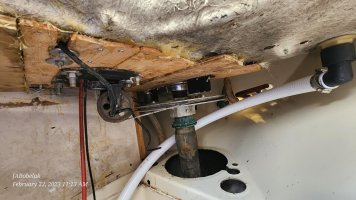Jaybee
Cocoa, FL 1984 30+
Like the title says, I'm waist deep into rewiring and a small amount of reconfiguring on my 30+
Next project is to remove this horribly bad job of what I'm assuming ISN'T factory plywood and fiberglass mess underneath the cockpit floor.


You can even see where it's making the rudder cables at an angle to the quadrant.
So, what's the question here you may be wondering - just making sure that this wasn't standard procedure from the factory to stiffen the floor?
In either, case I planned to put a new plywood ceiling back with thickened epoxy simply for having a surface to mount wiring, cables and hose runs to.
Next project is to remove this horribly bad job of what I'm assuming ISN'T factory plywood and fiberglass mess underneath the cockpit floor.


You can even see where it's making the rudder cables at an angle to the quadrant.
So, what's the question here you may be wondering - just making sure that this wasn't standard procedure from the factory to stiffen the floor?
In either, case I planned to put a new plywood ceiling back with thickened epoxy simply for having a surface to mount wiring, cables and hose runs to.

